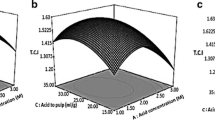Abstract
Studies were performed on the effects of small amounts of cellulose nanofibers and nanoclay particles on mechanical, physical and morphological properties of biodegradable composites of recycled thermoplastic starch biopolymer and regular mixed industrial sawdust of Iranian wood species including rush, walnut and hornbeam. To this aim, nanoparticles at 0, 3, and 5 wt% were added to the prepared biodegradable composites. Mechanical, thermal, water absorption and thickness swelling tests were performed according to their corresponding standards. In addition, to investigate the effects of working temperature on derived characteristics of the resulting composites, the selected mechanical tests were performed at various temperatures ranging from 23 to 80 °C. For validation of the results obtained from the physical tests, scanning electron microscopy was also utilized to examine the morphologies of the nanocomposites. The results showed that adding nanoparticles improved tensile modulus by 50%, tensile strength by 110%, flexural modulus by 115%, and flexural strength by 18%. Adding 5 wt% nanocellulose fibers showed better results than 3 wt% addition, while in the case of nanoclay, the trend was reverse. No significant change was observed for impact strength. Glass transition temperature was increased from 90 to 123 °C depending on the amount of nanoparticles. Water absorption and thickness swelling were reduced by around 20%. It was also observed that at elevated temperatures nanoparticles led to greater stability of the composite structure. From the results of this study it can be concluded that cellulose nanofibers and nanoclay particles can be successfully used for improving the mechanical and physical characteristics and performance of the biodegradable WPCs made of thermoplastic starch and industrial sawdust. Furthermore, since the effect of adding each of these nanoparticles on mechanical and physical performance of WPCs is different, the results of this study can be used to decide on selection of the type and amount of nanoparticles for fabrication of a product for a desired application.








Similar content being viewed by others
References
Satyanarayana KG, Arizaga GG, Wypych F (2009) Biodegradable composites based on lignocellulosic fibers—an overview. Prog Polym Sci 34:982–1021
Huang Z, Qian L, Yin Q, Yu N, Liu T, Tian D (2018) Biodegradability studies of poly (butylene succinate) composites filled with sugarcane rind fiber. Polym Test 66:319–326
Eslam HK, Saieh SE, Rajabi M (2011) Effect of steaming treatment on the physical and mechanical properties of WPC made of cotton flour and polypropylene. Aust J Basic Appl Sci 5:1143–1150
Tabassi N, Moghbeli MR, Ghasemi I (2016) Thermoplastic starch/cellulose nanocrystal green composites prepared in an internal mixer. Iran Polym J 25:45–57
Pappu A, Pickering KL, Thakur VK (2019) Manufacturing and characterization of sustainable hybrid composites using sisal and hemp fibers as reinforcement of poly (lactic acid) via injection moulding. Ind Crop Prod 137:260–269
Pappu A, Saxena M, Thakur VK, Sharma A, Haque R (2016) Facile extraction, processing and characterization of biorenewable sisal fibers for multifunctional applications. J Macromol Sci Part A 53:424–432
Janssen L, Moscicki L (2009) Thermoplastic starch: a green material for various industries. Wiley, Weinheim
Mortazavi S, Ghasemi I, Oromiehie A (2013) Prediction of tensile modulus of nanocomposites based on polymeric blends. Iran Polym J 22:437–445
Mirbagheri J, Tajvidi M, Ghasemi I, Hermanson JC (2007) Prediction of the elastic modulus of wood flour/kenaffibre/polypropylene hybrid composites. Iran Polym J 16:271–278
Averous L, Boquillon N (2004) Biocomposites based on plasticized starch: thermal and mechanical behaviours. Carbohyd Polym 56:111–122
Ku H, Wang H, Pattarachaiyakoop N, Trada M (2011) A review on the tensile properties of natural fiber reinforced polymer composites. Compos B 42:856–873
Deka BK, Maji TK (2011) Effect of TiO2 and nanoclay on the properties of wood polymer nanocomposite. Compos A 42:2117–2125
Beigloo JG, Eslam HK, Hemmasi AH, Bazyar B, Ghasemi I (2017) Effect of nanographene on physical, mechanical, and thermal properties and morphology of nanocomposite made of recycled high density polyethylene and wood flour. BioResources 12:1382–1394
Saeedi M, Ghasemi I, Karrabi M (2011) Thermal degradation of poly (vinyl chloride): effect of nanoclay and low density polyethylene content. Iran Polym J 20:424–432
Pappu A, Thakur VK (2017) Towards sustainable micro and nanocomposites from fly ash and natural fibers for multifunctional applications. Vacuum 146:375–385
Alemdar A, Sain M (2008) Biocomposites from wheat straw nanofibers: morphology, thermal and mechanical properties. Compos Sci Technol 68:557–565
Hietala M, Mathew AP, Oksman K (2013) Bionanocomposites of thermoplastic starch and cellulose nanofibers manufactured using twin-screw extrusion. Eur Polym J 49:950–956
Wang H, Zeng C, Elkovitch M, Lee LJ, Koelling KW (2001) Processing and properties of polymeric nanocomposites. Polym Eng Sci 41:2036–2046
Yeh SK, Gupta RK (2010) Nanoclay-reinforced, polypropylene-based wood–plastic composites. Polym Eng Sci 50:2013–2020
Author information
Authors and Affiliations
Corresponding author
Rights and permissions
About this article
Cite this article
Saieh, S.E., Eslam, H.K., Ghasemi, E. et al. Biodegradable composites of recycled thermoplastic starch and sawdust: the effect of cellulose nanofibers, nanoclay and temperature. Iran Polym J 28, 873–880 (2019). https://doi.org/10.1007/s13726-019-00750-2
Received:
Accepted:
Published:
Issue Date:
DOI: https://doi.org/10.1007/s13726-019-00750-2



